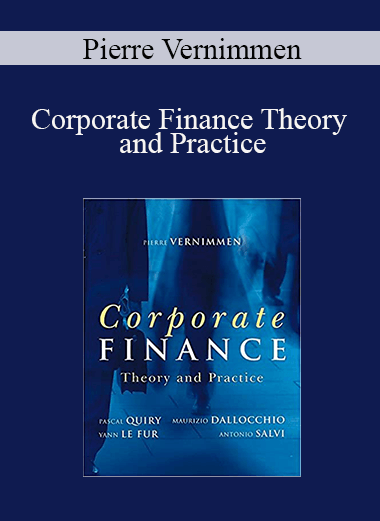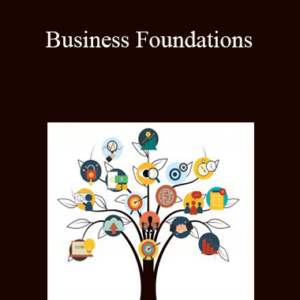Corporate Finance: Theory & Practice
By Pierre Vernimmen, Pascal Quiry, Yann Le Fur, Maurizio Dallochio, Antonio Salvi
Publisher: Wiley
ISBN-10: 0470092254
1059 pages
Adapted and updated from the original French, first published by E´ ditions Dalloz, Paris, 1994 (sixth edition 2005).
Corporate Finance:
Theory and Practice covers the theory and practice of Corporate Finance from a truly European perspective.
It shows how to use financial theory to solve practical problems and is written for students of corporate finance
and financial analysis and practising corporate financiers.
Corporate Finance is split into four sections and covers the basics of financial analysis;
the basic theoretical knowledge that you will need to value a firm; the major types of financial securities:
equity, debt & options and finally financial management which shows you how to organise a company’s equity capital,
buying and selling companies, M&A, bankruptcy and cash flow management.
Key features include:
* A section on financial analysis – a Corporate Financier must understand a company based on a detailed analysis of its accounts.
Large numbers neglected this approach during the last stock market bubble and were caught in the crash that inevitably followed.
How many investors took the trouble to read Enron’s annual report? Those who did found that it spoke volumes!
* End of Chapter Summary, Questions and Answers, Glossary, European Case Studies
* A supporting Website http://www.vernimmen.com with free access to statistics, a glossary & lexicon;
articles, notes on financial transactions, basic financial figures for more than 10,000 European and US listed companies,
thesis topics, a bibliography; case studies, Q&A; A letter box for your questions to the authors – a reply guaranteed within 72 hours!
* A free monthly newsletter on Corporate Finance sent out to subscribers to the site.
* The book, the website and the Vernimmen.com newsletter are all written and created by an author team
who are both investment bankers/corporate financiers and academics.
“Impressive book for finance professionals – Probably the best recently published Corporate Finance book with a truly European emphasis. The balance between theory and practice makes this book an excellent tool for Investment Bankers and other finance professionals, as it covers both basic as well as more sophisticated topics. Particularly impressive is their commitment to continuously updating material, as well as the regular publication of a newsletter containing timely articles on various current finance topics. The possibility of asking questions to the authors and effectively receiving in-depth answers for free is a very valuable feature. I sincerely recommend this text.” Amazon.co.uk 31 October 2005
“An excellent book for all business students – For a few months already, the Vernimmen.com website had been helping me for my finance class, as well as the monthly newsletter. I finally bought the book, and I have not been disappointed: the style is clear, very practical ; theories are mixed with real cases, which makes them easy to understand. Valuation techniques are well explained (discounted cash flow methods, methods based on ratios). Fundamental concepts (accounting, finance, financial markets) are recalled in the first part; when more complex concepts are tackled (investment analysis, LBOs, capital structure…), they are explained with lots of simplicity and conciseness.
I recommend this book for every student in Management or Finance!”
Amazon.co.uk 30 July 2005
Contents:
Foreword by Richard Roll xvi
Preface xviii
List of frequently used symbols xxii
1 What is corporate finance? 1
1.1 The financial manager is first and foremost a salesman . . . 1
1.2 . . . of financial securities . . . 4
1.3 . . . valued continuously in the financial markets 7
1.4 Most importantly, he is a negotiator . . . 10
1.5 . . . and he remembers to do an occasional reality check! 11
Section I Financial analysis 15
Part One Fundamental concepts in financial analysis 17
2 Cash flows 19
2.1 Operating and investment cycles 20
2.2 Financial resources 22
3 Earnings 29
3.1 Additions to wealth and deductions to wealth 29
3.2 Different income statement formats 34
4 Capital employed and invested capital 44
4.1 The balance sheet: definitions and concepts 45
4.2 The capital-employed analysis of the balance sheet 47
4.3 A solvency-and-liquidity analysis of the balance sheet 51
4.4 A detailed example of a capital-employed balance sheet 53
5 Walking through from earnings to cash flow 57
5.1 Analysis of earnings from a cash flow perspective 57
5.2 Cash flow statement 61
6 Getting to grips with consolidated accounts 73
6.1 Consolidation methods 73
6.2 Consolidation-related issues 80
6.3 Technical aspects of consolidation 85
7 How to cope with the most complex points in financial accounts 94
7.1 Accruals 95
7.2 Construction contracts 95
7.3 Convertible bonds and loans 96
7.4 Currency translation adjustments 97
7.5 Deferred tax assets and liabilities 97
7.6 Dilution profit and losses 99
7.7 Exchangeable bonds 100
7.8 Goodwill 100
7.9 Intangible fixed assets 101
7.10 Inventories 104
7.11 Leases 106
7.12 Mandatory convertible bonds 108
7.13 Off-balance-sheet commitments 108
7.14 Preference shares 110
7.15 Perpetual subordinated loans and notes 111
7.16 Provisions 111
7.17 Stock options 115
7.18 Tangible fixed assets 116
7.19 Treasury shares 117
Part Two Financial analysis and forecasting 121
8 How to perform a financial analysis 123
8.1 What is financial analysis? 123
8.2 Economic analysis of companies 125
8.3 An assessment of a company’s accounting policy 137
8.4 Standard financial analysis plan 138
8.5 The various techniques of financial analysis 139
8.6 Ratings 142
8.7 Scoring techniques 143
8.8 Expert systems 144
9 Margin analysis: Structure 155
9.1 How operating profit is formed 156
9.2 How operating profit is allocated 166
9.3 Financial assessment 167
9.4 Pro forma income statements (individual and consolidated accounts) 172
9.5 Case study: Ericsson 172
10 Margin analysis: Risks 178
10.1 How operating leverage works 178
10.2 A more refined analysis provides greater insight 182
10.3 From analysis to forecasting: the concept of normative margin 187
10.4 Case study: Ericsson 188
11 Working capital and capital expenditures 193
11.1 The nature of working capital 193
11.2 Working capital turnover ratios 197
Contents ix
11.3 Reading between the lines of working capital 201
11.4 Analysing capital expenditures 207
11.5 Case study: Ericsson 210
12 Financing 217
12.1 A dynamic analysis of the company’s financing 218
12.2 A static analysis of the company’s financing 220
12.3 Case study: Ericsson 227
13 Return on capital employed and return on equity 232
13.1 Analysis of corporate profitability 232
13.2 Leverage effect 234
13.3 Uses and limitations of the leverage effect 243
13.4 Case study: Ericsson 246
14 Conclusion of financial analysis 252
14.1 Solvency 252
14.2 Value creation 254
14.3 Financial analysis without the relevant accounting documents 255
14.4 Case study: Ericsson 256
Section II Investment analysis 259
Part One Investment decision rules 261
15 The financial markets 263
15.1 The rise of capital markets 263
15.2 The functions of a financial system 268
15.3 The relationship between banks and companies 270
15.4 From value to price (1): financial communication 271
15.5 From value to price (2): efficient markets 272
15.6 Limitations in the theory of efficient markets 277
15.7 Investors’ behaviour 282
16 The time value of money and Net Present Value (NPV) 290
16.1 Capitalisation 290
16.2 Discounting 294
16.3 Present value and net present value of a financial security 296
16.4 The NPV decision rule 297
16.5 What does net present value depend on? 298
16.6 Some examples of simplification of present value calculations 299
16.7 Special NPV topics 302
17 The Internal Rate of Return (IRR) 309
17.1 How is internal rate of return determined? 309
17.2 Internal rate of return as an investment criterion 310
17.3 The limits of the internal rate of return 310
17.4 Some more financial mathematics: interest rate and yield to maturity 317
18 Incremental cash flows and other investment criteria 327
18.1 The predominance of NPV and the importance of IRR 327
18.2 The main lines of reasoning 329
18.3 Which cash flows are important? 333
18.4 Other investment criteria 334
19 Measuring value creation 345
19.1 Accounting criteria 348
19.2 Economic criteria 353
19.3 Market criteria 357
19.4 Putting things into perspective 359
20 Risk and investment analysis 367
20.1 A closer look at risk 368
20.2 The contribution of real options 373
Part Two The risk of securities and the cost of capital 385
21 Risk and return 387
21.1 Sources of risk 387
21.2 Risk and fluctuation in the value of a security 389
21.3 Tools for measuring return and risk 392
21.4 How diversification reduces risk 394
21.5 Portfolio risk 396
21.6 Measuring how individual securities affect portfolio risk: the beta coefficient 401
21.7 Choosing among several risky assets and the efficient frontier 405
21.8 Choosing between several risky assets and a risk-free asset: the capital market line 407
21.9 How portfolio management works 411
22 The cost of equity 419
22.1 Return required by investors: the CAPM 420
22.2 Properties of the CAPM 424
22.3 The limits of the CAPM model 425
22.4 Multifactor models 429
22.5 The cost of equity based on historical returns 432
22.6 The cost of equity based on current market prices 434
22.A A formal derivation of the CAPM 440
23 From the cost of equity to the cost of capital 443
23.1 The cost of capital and the of assets 443
23.2 Alternative methods for estimating the cost of capital 444
23.3 Some practical applications 450
23.4 Can corporate managers influence the cost of capital? 453
23.5 Cost of capital: a look at the evidence 455
24 The term structure of interest rates 461
24.1 Fixed income securities and risk 461
24.2 The different interest rate curves 463
24.3 Relationship between interest rates and maturities 466
24.4 The stochastic approach to modelling the rate structure 469
24.5 A flashback 469
Section III Corporate financial policies 473
Part One Financial securities 475
25 Enterprise value and financial securities 477
25.1 A completely different way of looking at things 477
25.2 Debt and equity 478
25.3 Overview of how to compute enterprise value 480
25.4 Valuation by discounting free cash flows 480
26 Debt securities 485
26.1 Basic concepts 487
26.2 The yield to maturity 489
26.3 Floating rate bonds 492
26.4 Other debt securities 495
26.5 The volatility of debt securities 499
26.6 Default risk and the role of rating 503
27 Managing net debt 512
27.1 General features of corporate financing 512
27.2 Marketable debt securities 517
27.3 Bank debt products 520
27.4 Leasing 527
27.5 Project financing 530
27.6 Investment of cash 533
28 Shares 538
28.1 Basic concepts 538
28.2 Price/Earnings ratio 545
28.3 Key market data 548
28.4 Adjusting per-share data for technical factors 550
29 Options 556
29.1 Definition and theoretical foundation of options 557
29.2 Mechanisms used in pricing options 559
29.3 Analysing options 561
29.4 Parameters to value options 564
29.5 Methods for pricing options 566
29.6 Tools for managing an options position 570
30 Hybrid securities 577
30.1 Warrants 578
30.2 Convertible bonds 582
30.3 Preference shares 588
30.4 Other hybrid securities 591
31 Selling securities 601
31.1 General principles in the sale of securities 601
31.2 Initial public offerings (IPOs) 607
31.3 Capital increases 613
31.4 Block trades of shares 618
31.5 Bonds 620
31.6 Convertible and exchangeable bonds 626
31.7 Syndicated loans 626
Part Two Capital structure policies 635
32 Value and corporate finance 637
32.1 The purpose of finance is to create value 637
32.2 Value creation and markets in equilibrium 640
32.3 Value and organisation theories 644
32.4 How can we create value? 650
32.5 Value and taxation 651
33 Capital structure and the theory of perfect capital markets 657
33.1 The evidence from the real world 658
33.2 The capital structure policy in perfect financial markets 660
34 The tradeoff model 668
34.1 The benefits of debt 669
34.2 The costs of debt 681
34.3 The tradeoff model 687
34A The capital structure choice: the Endesa case 695
35 Debt, equity and options theory 698
35.1 Analysing the firm in light of options theory 699
35.2 Contribution of the options theory to the valuation of equity 701
35.3 Using options theory to analyse a company’s financial decisions 704
35.4 Resolving conflicts between shareholders and creditors 708
36 Working out details: The design of the capital structure 716
36.1 The major concepts 717
36.2 Competitors, lifecycle and other capital structure determinants 722
36.3 Other factors affecting the capital structure choice 726
36.4 Effects of the financing choice on accounting and financial criteria 729
36.5 Working out the details of the capital structure 733
36.6 Capital structure policies: a look at the evidence 741
36A Capital structure design: the Alitalia case 747
Part Three Equity capital and dividend policies 753
37 Internal financing: Reinvesting cash flow 755
37.1 Reinvested cash flow and the value of equity 756
37.2 Internal financing and the various stakeholders 759
37.3 Internal financing and return criteria 760
38 Returning cash to shareholders: Dividend policies 768
38.1 Dividends and market value 768
38.2 Dividend distribution in practice 772
38.3 Share buybacks 778
38.4 Taxation of dividends, share buybacks and capital reduction 783
39 Capital increases 792
39.1 A definition of capital increase 792
39.2 Capital increases and finance theory 794
39.3 Old and new shareholders 796
39.4 Capital increases and financial criteria 799
Section IV Financial management 809
Part One Valuation and financial engineering 811
40 Valuation 813
40.1 Overview of the different methods 813
40.2 Premiums and discounts 814
40.3 Valuation by discounted cash flow 818
40.4 Multiple approach or peer group comparisons 826
40.5 The sum-of-the-parts method and Restated Net Asset Value (RNAV) 832
40.6 Example: valuation of Ericsson 835
40.7 Comparison of valuation methods 837
41 Choice of corporate structure 844
41.1 Shareholder structure 844
41.2 Initial Public Offerings (IPOs) and corporate governance 853
41.3 How to strengthen control over a company 857
41.4 Financial securities’ discounts 865
41.5 Organising a diversified group 867
42 Taking control of a company 873
42.1 The rise of mergers and acquisitions 873
42.2 Choosing a negotiating strategy 877
42.3 Taking over a listed European company 882
43 Mergers and demergers 894
43.1 All-share deals 894
43.2 The mechanics of all-share transactions 899
43.3 Demergers and splitoffs 904
44 Leveraged buyouts (LBOs) 912
44.1 LBO structures 912
44.2 The players 915
44.3 LBOs and financial theory 920
45 Bankruptcy and restructuring 923
45.1 Causes of bankruptcy 923
45.2 Bankruptcy and financial theory 928
45.3 An illustrative example of financial restructuring 931
Part Two Managing net debt and financial risks 937
46 Managing cash flows 939
46.1 Basic tenets 939
46.2 Cash management 942
46.3 Cash management within a group 947
46.4 Investment of cash 951
47 Asset-based financing 956
47.1 Reasons for using asset-based financing 956
47.2 Main techniques 958
47.3 Accounting treatment 964
47.4 Consequences for financial analysis 968
48 Managing financial risks 972
48.1 The various sources of financial risk 972
48.2 Measuring financial risks 973
48.3 Principles of financial risk management 975
48.4 Organised markets–OTC markets 985
Glossary 992
Index 1002
Vernimmen.com 1031
Cribsheet 1032
Get download Pierre Vernimmen – Corporate Finance Theory and Practice at coursesblock.com right now!
Delivery Method
– After your purchase, you’ll see a View your orders link which goes to the Downloads page. Here, you can download all the files associated with your order.
– Downloads are available once your payment is confirmed, we’ll also send you a download notification email separate from any transaction notification emails you receive from coursesblock.com
– Since it is a digital copy, our suggestion is to download and save it to your hard drive. In case the link is broken for any reason, please contact us and we will resend the new download link.
– If you cannot find the download link, please don’t worry about that. We will update and notify you as soon as possible at 8:00 AM – 8:00 PM (UTC 8).
Thank You For Shopping With Us!




![[Download Now] Luigi Ontiveros – Wholesale Business Blueprint](https://coursesblock.com/wp-content/uploads/2024/10/Luigi-Ontiveros-Wholesale-Business-Blueprint-1-300x300.jpg)


